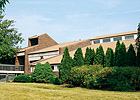
Renovation of this commercial office building in Maryland required one office space to be turned into four, with individual controls necessary. A combined system with energy recovery elements allowed the building to be served by a smaller system, reducing tonnage requirements from 25 to 18 tons and providing lower energy costs.
Reducing cooling equipment size and cost, while still providing sufficient A/C to all the tenants in a building was the dilemma facing Oasis Mechanical of Lanham, MD. The company was being asked to meet the needs of the Greenbriar Community Building in Greenbelt, MD, a small commercial office building (approximately 6,000 sq ft) that was undergoing a renovation.
Originally, the building was occupied by a single tenant, however, when that tenant moved to a new location, the building owner decided to partition the building into four separate business offices. As a result, the renovated, single-story facility required four separate HVAC systems to allow each tenant to control their individual heating and cooling requirements.
The Original Plan
“The original plan called for four separate heat pump systems: two 7.5-ton and two 5-ton systems, for a total of 25 tons of heating and cooling. At 12,000 Btu/ton, that was a considerable load. In addition, each zone required approximately 260 cfm of untempered fresh air, per the ASHRAE 62.1 ventilation code,” said Dennis Bean of Oasis Mechanical.Several contractors bid the project as originally specified, including Oasis Mechanical. With the four separate systems - two of which required their own mechanical room in the office space - the cost in terms of equipment dollars and lost billable space was significant.
“We sensed from the beginning that the scope of the project might be an issue,” said Oasis’ Rick Cummings, “so we brought in Ken Herne, a SpacePak representative with Harry Eklof Associates.” SpacePak is a high velocity A/C system originally designed for installation in residential applications where traditional A/C ductwork isn’t an option. The system is also used in commercial applications, and in this case of the Greenbriar facility, it was an ideal choice.
Oasis Mechanical had installed several SpacePak systems in condominium buildings, and Bean and Cummings thought that the Greenbriar facility might also benefit from a SpacePak system. They were concerned, however, that the largest SpacePak system, at five tons, wouldn’t be large enough for the application.
Will It Work?
Herne was brought in to evaluate the project and see if a SpacePak system could work. The need to meet ASHRAE 62.1 complicated the project. Herne confirmed that the 5-ton SpacePak system would not be sufficient, but he suggested an unusual solution - marry the SpacePak system to an energy recovery system.Herne and his team discovered the Lifebreath TRV energy recovery equipment, which allowed them to reduce the load of the untempered fresh air by 65% and still meet the ASHRAE 62.1 requirement.
The TRV system is a compact dual-core system designed to move stale, contaminated air from inside to the outside. At the same time, the system draws clean fresh air in from the outside. The two airstreams pass through the TRV without mixing. Instead, they pass on either side of a heat recovery vehicle- (HRV) style heat exchanger core first (sensible load) which transfers heat from the outgoing to the incoming air, and then an energy recovery vehicle- (ERV) style core, which reduces the latent load of the untempered air in the summer, and helps maintain humidity levels of the space in the winter by providing fresh but tempered air into the facility.
Two Fives + Two Fours = $80,000
“With the combined system and ventilation recovery equipment, we reduced the total system tonnage requirement from 25 tons to 18 tons. The new system would include two 5-ton units and two 4-ton units, which had offered several benefits,” said Herne.First, the newly configured system reduced the overall cost of the equipment for the owner, the need for conventional A/C ductwork, and also the labor by one-third for installing the system. This shaved approximately $80,000 from the original project estimate.
Second, the SpacePak equipment was small enough that it didn’t require a separate mechanical room in the office space, which provided the building owner with more billable space.
Third, due to the flexibility of the system and the 2-in. flexible ductwork, the system can be easily re-arranged down the road if or when the space requires further reconfiguration.
Last but not least, the downsized equipment is seven tons smaller and will provide a significant energy operating cost savings to the owner on an ongoing basis.
“The owner is very happy with the solution,” said Cummings. “Oasis Mechanical provided a unique solution to his problem by working closely with the local sales representative and design engineering firm.”
